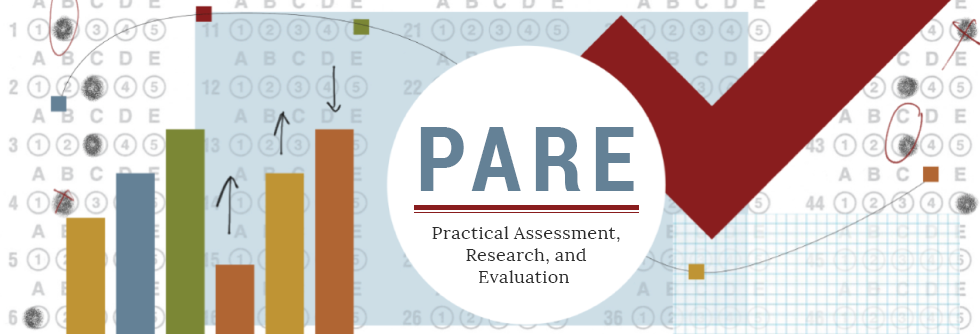Submission Guidelines
Contents
- Who Can Submit?
- General Submission Rules
- PARE Manuscript Submission Requirements
- General Formatting Guidance
- Instructions to Special Issue Organizers
Who Can Submit?
Anyone may submit an original article to be considered for publication in Practical Assessment, Research, and Evaluation provided he or she owns the copyright to the work being submitted or is authorized by the copyright owner or owners to submit the article. Authors are the initial owners of the copyrights to their works (an exception in the non-academic world to this might exist if the authors have, as a condition of employment, agreed to transfer copyright to their employer).
General Submission Rules
Submitted articles cannot have been previously published, nor be forthcoming in an archival journal or book (print or electronic). Please note: "publication" in a working-paper series does not constitute prior publication. In addition, by submitting material to PARE, the author is stipulating that the material is not currently under review at another journal (electronic or print) and that he or she will not submit the material to another journal (electronic or print) until the completion of the editorial decision process at PARE. If you have concerns about the submission terms for PARE, please contact the co-editors.
PARE Manuscript Submission Requirements
All PARE submissions adhere to the following technical specifications:
- Length: 2,000 to 8,000 words, or about eight to ten pages in length, exclusive of tables and references.
- Content: Clear, unique, and generalizable implications for practice in education, certification, or licensure.
- Format: Submissions must be double-spaced, with 12 point font and 1 inch margins. PDF, Microsoft Word, or RTF are accepted. LaTeX can be submitted for review, but accepted manuscripts must be submitted in PDF and/or Word.
- Blind Submission: Manuscripts should be submitted without author names. In addition, submitting authors should do their best to keep their identities anonymous by not citing their own work excessively or gratuitously. For example, references to unpublished reports or conference papers should be avoided if possible. Please do not blind a reference to a previous publication by the author("Author, 2012").
- Style: Articles should be prepared with sections and subheadings in accordance with the APA Publication Manual, and should be written clearly and concisely.
- Manuscripts must be submitted without the title or abstract in the body of the submission. You will be asked to enter the title and an abstract of 200 words or less on the online submission form.
- Tables and graphs should appear in the body of the submission, not at the end.
- Manuscripts should be submitted electronically on the journal website, at Submit Article.
General Formatting Guidance
Manuscripts submitted to PARE must adhere to the principles and format outlined in the current edition of the Publication Manual of the American Psychological Association.
The APA Publication Manual provides detailed information about the entire process of publication - from organizing, writing, formatting, and submitting a manuscript, to seeing the accepted manuscript through production and publication.
There is additional guidance that authors may find helpful governing the formatting of the submission. See Manuscript Preparation Guidelines for details. Although bepress can provide limited technical support, it is ultimately the responsibility of the author to produce an electronic version of the article as a high-quality PDF (Adobe's Portable Document Format) file, or a Microsoft Word or RTF file that can be converted to a PDF file.
It is understood that the current state of technology of Adobe's Portable Document Format (PDF) is such that there are no, and can be no, guarantees that documents in PDF will work perfectly with all possible hardware and software configurations that readers may have.
Instructions to Special Volume Organizers
The Co-Editors welcome proposals from authors that identify a cluster of 3-5 papers for publication together as a special volume of PARE. Special volumes should be organized around a topic of current interest in assessment and evaluation and should offer a range of perspectives and/or investigate the topic from multiple approaches
The organizer of the special volume should send the Editors a short proposal by email that includes:
- An abstract (about one page) to introduce the topic. This abstract must also explain the importance of the topic, give reasons for dedicating a special volume of PARE to it, and provide details as to how the proposed special volume will appeal to the broad readership of PARE.
- A list of manuscripts included in the special volume proposal and authors with affiliations.
- Abstracts of about half a page in length for each manuscript.
- A proposed timetable for the final submission of all the materials that are included in the proposal for the special volume.
If the Co-Editors accept the special volume proposal, the authors must upload the full manuscripts into PARE's submission system on the timeline agreed upon.
Each paper submitted as part of a special volume will go through a peer review process and all authors will receive feedback on the submitted manuscripts. Authors must address comments and edits received prior to final acceptance and publication.
